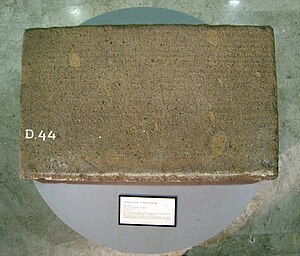| Kelurak inscription | |
|---|---|
 Kelurak inscription, displayed at National Museum of Indonesia, Jakarta | |
| Material | Andesite stone |
| Writing | Pranagari script in Sanskrit |
| Created | 704 Saka (782 CE) |
| Discovered | Lumbung temple in Kelurak village, Klaten Regency, located not far north of Prambanan temple, Central Java, Indonesia |
| Present location | National Museum of Indonesia, Jakarta |
| Registration | D.44 |
The Kelurak inscription is an inscription dated 704 Saka (782 CE), written in Sanskrit with Pranagari script, discovered near Lumbung temple in Kelurak village, Central Java, Indonesia. Lumbung temple is a bit north of Prambanan temple in Yogyakarta.
The writings on the inscription were discovered in poor condition with several parts being unclear and unreadable, as a result, historians could only translate the main information of the inscription.